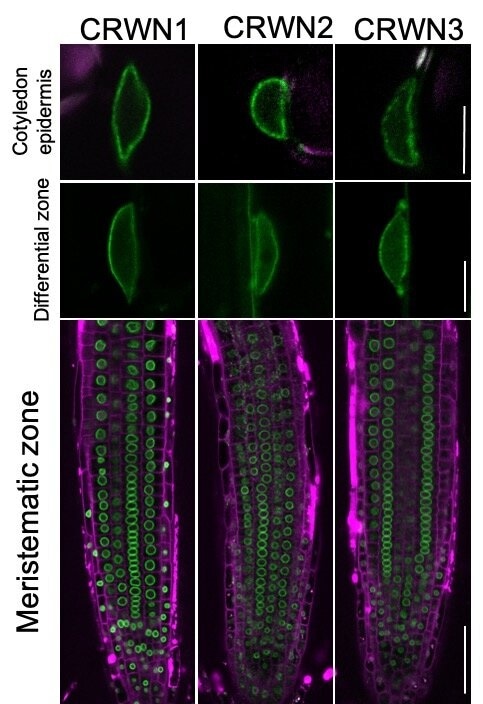Scientists from the University of Tokyo have learned how the layout of the cell nucleus can alter the activity of genes found in plants.

Fluorescent confocal microscopy images of 8-day-old Arabidopsis thaliana roots. The purple color shows cell walls and the green color shows CRWN1-3 in the immature leaf (top, cotyledon epidermis), mature area of the root (middle, differential zone) and actively growing end of the root (bottom, meristematic zone). Image Credit: © Yuki Sakamoto.
This latest finding demonstrates the underlying understanding of the regulation of genes and points towards upcoming techniques for potentially exploiting the expression of several genes at the same time.
The protein machinery and the long DNA strands required to switch the expression of genes on or off are contained, floating inside the cell nuclei. In essence, the nucleus is a sack composed of a flexible, double-membrane envelope supported by the nuclear lamina—an inner, fine-mesh frame of proteins.
DNA does not drift aimlessly within the nucleus. We expect that there is nonrandom spatial positioning of genes around the nuclear lamina.”
Sachihiro Matsunaga, Study Lead and Professor, Graduate School of Frontier Sciences University of Tokyo
The study was recently published in the Nature Communications journal.
Most often, gene regulation is investigated at the one-dimensional (1D) level of reading the sequence of DNA. Supplementary layers of gene regulation exist in 3D by altering the outline of the DNA strand.
Some examples comprise the epigenetic code that governs how the DNA strands should be would up tightly, and the “kissing genes” phenomenon” in which remote portions of the DNA strand fold collectively and modify the activity of the genes that make contact with one another.
The latest results offer proof for yet another 3D technique of gene regulation, in which both the architecture of the genome and the architecture of its container—the nucleus—are involved.
For a long time, the scientific community had known that the size and shape of the nucleus can vary significantly during the life of a cell and that such variations can even be timed as an “internal clock” to establish a cell’s age.
But scientists had made these findings with the help of animal cells. Plants lack the kind of genes that are evolutionarily associated with the genes accountable for the nuclear lamina found in animals.
Textbooks usually have a few sentences about animal lamina, but nothing at all to say about plant lamina.”
Sachihiro Matsunaga, Study Lead and Professor, Graduate School of Frontier Sciences University of Tokyo
Previous studies performed in 2013 by a few members of the research group detected a set of four proteins, called CROWDED NUCLEI (CRWN), as the most probable constituents of the nuclear lamina in plants.
To validate the presence of CRWN proteins in the lamina, investigators initially fixed fluorescent tags onto the proteins and extracted nuclei from the root cells of young thale cress plants—the roadside weed often utilized in research laboratories. The team then quantified the location of the proteins in ultrahigh-resolution microscopy images.
Such highly zoomed-in images reveal web-like patterns that are created by the CRWN proteins around the nuclear shell. An oval-shaped nucleus is found in healthy plant cells and this looks similar to a huge egg in the middle of the cell.
Plants that are genetically modified to lack the CRWN proteins have smaller and rounder nuclei than the normal ones, probably producing a more crowded surrounding for the DNA within.
Investigators subsequently screened the genetically modified plants to observe whether any other genes had different levels of activity upon suppressing the CRWN genes. Numerous genes known to play a role in responding to copper levels were less active. This indicates that the nuclear lamina is somehow linked to copper tolerance.
Plants lacking the CRWN proteins grow shorter when compared to the healthy ones even in regular soil. The Thale cress plants that had inactive CRWN genes and were planted in soil with high levels of copper grew even smaller with a considerably weaker appearance. This provides additional proof that the nuclear lamina plays a role in the response of plants to environmental stress.
The investigators also observed the physical site of copper tolerance genes inside the nucleus of both high and normal copper levels. In the case of healthy plants in the high-copper condition, the copper tolerance genes grouped together and shifted even closer to the edge of the nucleus. The copper tolerance genes seemed to spread out and drift around the nuclei in plants with inactive CRWN genes.
If the plant nucleus has distinct regions for active transcription of DNA, it is likely that those regions will be near the nuclear lamina. This is important and interesting because it is opposite to animal cells, which we know have active regions in the center of nuclei while the periphery is inactive.”
Sachihiro Matsunaga, Study Lead and Professor, Graduate School of Frontier Sciences University of Tokyo
A majority of the gene-editing technologies developed to decrease or increase gene activity directly work at the 1D level of modifying the DNA sequence of the individual gene.
Interoperating the way nuclear lamina influents the expression of genes could disclose upcoming techniques for modifying the activity of several genes simultaneously by remolding the nuclear lamina and genome.
Source:
Journal reference:
Sakamoto, Y., et al. (2020) Subnuclear gene positioning through lamina association affects copper tolerance. Nature Communications. doi.org/10.1038/s41467-020-19621-z.